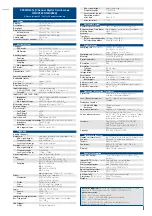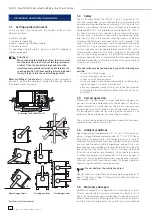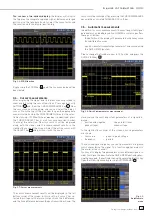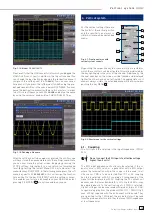
19
Subject to change without notice
T r i g g e r S y s t e m
ditions only once, the key SINGLE must be pushed, it will light
up white. This indicates that the single trigger mode is active,
the RUN/STOP key will blink. The next return of the signal will
cause a single capture, the oscilloscope then goes into the STOP
mode, indicated by the RUN/STOP key lighting up in red.
6.2. Trigger
sources
Trigger sources are the 2 (with HMO3522) or 4 (with HMO3524)
analog channels and the external trigger input. If the optional
logic probe HO3508 with 8 or 16 logic channels is connected,
also those up to 16 digital channels can serve as trigger
sources.
6.3. Slope
trigger
The simplest and most used trigger type is slope trigger, this
one is also selected in the AUTOSETUP function. Pushing the
AUTOSETUP key will hence change any previously selected
trigger type to slope trigger. For the selection of the trigger
type push the key TYPE in the trigger control section of the front
panel. A menu will open and offer the options. If the type SLOPE
was not selected (blue background) pushing the respective soft
key will change to slope. The SLOPE key is also used to step
through the options rising, falling, or both slopes. In the center
of the status line top center above the graticule the type selected
will be shown. If the key FILTER is pushed, the respective menu
will open and offer the available options.
Here the trigger signal coupling can be selected:
DC:
The trigger signal is used with its dc content.
AC:
The trigger signal is routed via a 5 Hz high pass fi lter.
HF:
The trigger signal is routed via a 15 kHz high pass fi lter.
The trigger level is no longer adjustable. This mode
should only be used with very high frequency signals.
LOW PASS:
The trigger signal is routed via a 5 kHz low pass
fi lter.
NOISE RED.:
The trigger signal is routed via a 100 MHz low
pass fi lter removing higher frequency interference.
The coupling modes low pass and noise reduction can not be
simultaneously selected, but they can be used with DC or AC
coupling.
Fig. 6.3: The type B-Trigger
The slope trigger can be coupled with a so called „B Trigger“.
This option is available after pushing TYPE. This function allows
you to adjust the trigger such that fi rst condition „A“ must be met
and then another condition „B“ before the trigger will respond
(refer to Fig. 6.3).
E.g. it is possible to defi ne a source (channel) and a level of
120 mV on the rising slope of that signal and for the second
condition a level of 80 mV on the falling slope. Additionally, it is
possible to defi ne whether the B event should occur a time (min.
8 ns) or a number (min. 1) of times after the A event. The level or
time or the number of events can be entered numerically with
the universal knob or in a submenu. In order to do this fi rst select
the setting, then push the soft key next to
NUMER. ENTRY
. In
the window which will open, you can enter numbers and units
with the combination of universal knob, the CURSOR SELECT
key and the visible softmenu functions.
6.4. Pulse
trigger
The pulse trigger allows you to trigger on fi nite pulse widths of
positive or negative pulses, or ranges thereof. Select the pulse
trigger by pushing the key TYPE and the respective soft key
next to PULSE. Further settings are available in the soft menu
after pushing FILTER.
There are 6 options:
ti ≠ t: The pulse width ti is unequal to the reference width t.
ti = t: The pulse width ti is equal to the reference width t.
ti
<
t: The pulse width ti is smaller than the reference width t.
ti
>
t: The pulse width ti is greater than the reference width t.
t
1
<
ti
<
t
2
: The pulse width ti, is smaller than the reference width
t
2
and greater than the reference width t
1
.
not(t
1
<
ti
<
t
2
): The pulse width ti, is greater than the reference
width t
2
and smaller than the reference width t
1
.
First select the desired option and then adjust the desired re-
ference time. If you choose „ti ≠ t“ od „ti = t“, you can select the
reference time after pushing the soft key next to TIME by turning
the universal knob. If you choose the soft menu item DEVIATION
the universal knob is used to defi ne a tolerance interval. If you
chose ti
<
t or ti
>
t, you can only defi ne one limit. Both options
with two references (t
1
and t
2
) can be set due to pressing the re-
spective soft key and turning the universal knob. All these settings
can be combined with positive or negative pulses by selecting
the respective soft menu keys. With positive pulses the width is
defi ned from the rising to the falling slopes, with negative pulses
from the falling to the rising slopes. Triggering will then be on the
second slope of the pulse.
Fig. 6.4: Pulse trigger menu
Содержание Hameg HMO3522
Страница 1: ...350 MHz Digital Oscilloscope with FFT and mixed signal option HMO3522 3524 Manual English...
Страница 33: ...33 Subject to change without notice A p p e n d i x...
Страница 34: ...34 Subject to change without notice Appendix...
Страница 35: ...35 Subject to change without notice A p p e n d i x...
















































